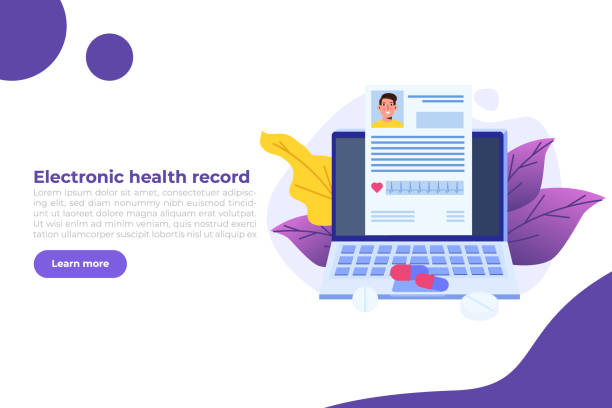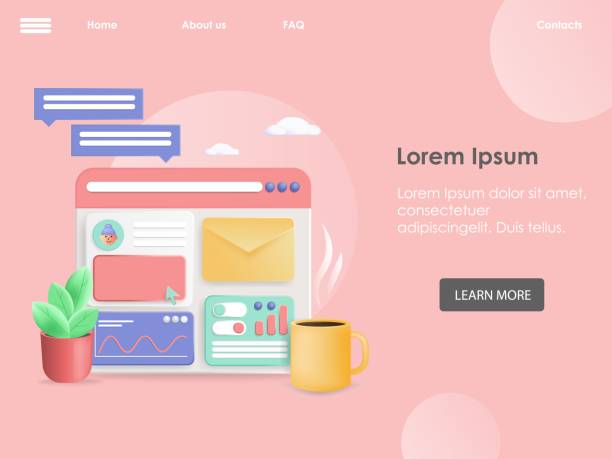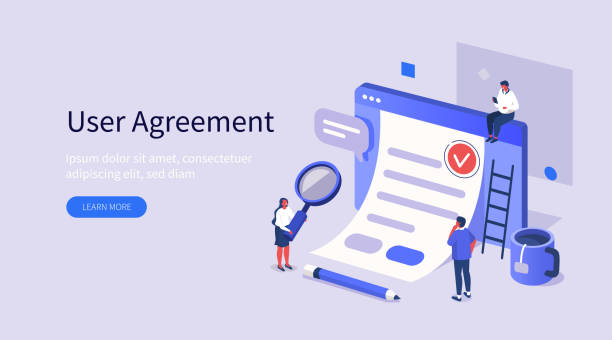The Importance of SEO-Optimized Website Design in Today’s World

In the current digital age, merely having a website is not enough; your website must be discoverable and visible.
This is where the concept of SEO-optimized website design becomes critically important.
#SEO, or Search Engine Optimization, is a process that helps your website achieve a higher ranking in the search results of engines like Google, Bing, and Yahoo.
The main goal of #website_design with an SEO approach is to increase organic (natural) and targeted traffic to your website.
This traffic consists of users who are actively searching for the products, services, or information you provide.
In fact, a strong presence in #search_engines not only enhances your brand’s credibility but also opens a gateway to countless business opportunities and connection with a wider audience.
A website that is not properly optimized for search engines is like a beautiful shop window on a deserted street; no matter how valuable its content, if no one can find it, it will have no value.
Therefore, investing in SEO-optimized website design is a long-term and smart strategy for any business seeking sustainable success in the online space.
This approach is not just about using keywords; it includes a set of technical, content, and user experience techniques that all together improve your site’s performance in the eyes of search engines.
We will delve into these topics in detail further on and clarify their various dimensions for you.
Tired of losing customers due to poor e-commerce website design? Solve this problem forever with RasaWeb!
✅ Increase sales and visitor-to-customer conversion rate
✅ Smooth and engaging user experience for your customers⚡ Get free consultation
Basic SEO Principles in Website Design

To achieve an SEO-optimized website design, it is necessary to be familiar with basic SEO principles and apply them from the very beginning of the website design process.
These principles include three main pillars: Technical SEO, On-Page SEO, and Off-Page SEO.
Technical SEO deals with optimizing the technical aspects of a website to make it easier for search engines to crawl and index.
This includes website loading speed, mobile-friendliness, appropriate URL structure, the use of a sitemap and robots.txt file, and website security (HTTPS).
If your website is not technically strong, even the best content cannot bring it to high rankings. On-Page SEO focuses on optimizing the content and elements within your website’s pages, such as selecting appropriate keywords, optimizing meta titles, meta descriptions, heading tags (H1-H6), content quality and length, optimized image usage, and internal links.
Every element on the page should help search engines understand the page’s topic and present it to relevant users.
Off-Page SEO also includes activities outside your website that help increase domain authority, such as backlinking from other reputable websites.
These three pillars together create a solid structure for your website that is not only optimized for search engines but also provides an enjoyable user experience for visitors.
This comprehensive approach ensures success in the path of SEO-optimized website design.
Technical Website Optimization for Search Engines

Technical optimization is the backbone of any SEO-optimized website design, and without it, your efforts in other areas may be fruitless.
Website loading speed is one of the most critical technical factors that directly impacts user experience and SEO ranking.
Today’s users expect websites to load in less than a few seconds, and search engines prioritize sites with higher speed.
To improve speed, one can utilize image compression, caching, code optimization (CSS, JavaScript, HTML), and content delivery networks (CDN).
Mobile-friendliness is another factor that Google has considered a significant ranking factor for years.
Given the significant increase in mobile device usage for searching and browsing the web, your website must be responsive and display well on various screen sizes.
Logical and understandable URL structures not only help users better comprehend page content but also make it easier for search engines to crawl your content.
Furthermore, using the HTTPS protocol (website security) is no longer an option but a necessity.
Websites with SSL certificates are preferred by Google and provide users with greater peace of mind.
Creating an XML Sitemap and a robots.txt file also helps search engines better understand your website’s structure and correctly index important pages.
Managing 404 errors and 301 redirects for deleted or moved pages is also highly important to prevent user experience disruption and loss of link equity.
These are just some of the technical complexities in the path of SEO-optimized website design that must be implemented with high precision and expertise.
Table 1: Key Factors in Technical Website SEO
| Technical Factor | Importance for SEO | Improvement Solutions |
|---|---|---|
| Loading Speed | Very important, direct impact on UX and ranking | Image compression, caching, CDN, code optimization |
| Mobile Compatibility | Essential, Google ranking factor | Responsive design, testing with Mobile-Friendly Test |
| Security (HTTPS) | Ranking factor, increases user trust | Install SSL certificate |
| URL Structure | High importance for crawling and content understanding | Use short, descriptive URLs that include keywords |
| XML Sitemap | Helps search engines index faster | Create and submit sitemap to Google Search Console |
SEO-Optimized Content Production and Keyword Strategy

Content is king; this phrase holds true more than ever in the world of SEO, especially in the field of SEO-optimized website design.
Producing SEO-optimized content goes beyond merely writing text; it involves understanding audience needs, conducting in-depth keyword research, and providing valuable and engaging content that is optimized for both users and search engines.
The first step in this path is keyword research.
You need to identify the words your target audience uses to search for your products or services.
Tools like Google Keyword Planner, Ahrefs, Semrush, and Moz Keyword Explorer can assist you in this process.
The goal is not only to find high-volume keywords but also to discover long-tail keywords that better indicate user intent and have less competition.
After selecting keywords, it’s time to produce content.
Your content should be comprehensive, accurate, unique, and user-friendly.
Natural use of keywords in titles, subtitles, paragraphs, and images (in alt text) is very important.
Strictly avoid excessive repetition of keywords (keyword stuffing), as this not only harms your ranking but also diminishes the user experience.
Your content should answer users’ questions and create added value for them.
In addition to text, using various content formats such as videos, infographics, podcasts, and high-quality images can increase your website’s attractiveness and improve user dwell time, which is itself a positive signal for search engines.
Furthermore, regularly updating old content and adding fresh material indicates continuous activity on your website and signals to search engines that your site is an active and trustworthy resource.
Implementing these strategies ensures that your site is a truly SEO-optimized website design, not only technically but also in terms of content.
Frustrated with the low conversion rate of your e-commerce site? RasaWeb transforms your e-commerce site into a powerful tool for attracting and converting customers!
✅ Significant increase in visitor-to-buyer conversion rate
✅ Unparalleled user experience to boost customer satisfaction and loyalty⚡ Get free consultation from RasaWeb!
The Role of User Experience (UX) in Site SEO

In recent years, the convergence between SEO and User Experience (UX) has become one of the most important topics in the field of SEO-optimized website design.
Search engines, especially Google, have developed their algorithms to not only pay attention to keywords and backlinks but also to how users interact with the website.
An excellent user experience (UX) means a site that is not only visually appealing but also offers easy navigation, high speed, and accessible, useful content.
When users visit your website and have a positive experience, the likelihood of them staying on the site, viewing more pages, and returning increases.
These signals, such as Dwell Time, Bounce Rate, and Click-Through Rate (CTR) in search results, are very important for search engines.
A low bounce rate and high dwell time indicate that users found your content useful, which in turn improves your ranking in search results.
UX elements that impact SEO include:
- **Easy and Intuitive Navigation:** Clear menu structure, logical internal links, and site search functionality help users and search engine crawlers easily move around your site.
- **Responsive and Mobile-Friendly Design:** As mentioned before, mobile-first design is crucial, as a significant portion of web traffic comes from mobile devices.
- **Page Loading Speed:** Faster pages offer a better user experience and reduce bounce rates.
- **Content Readability:** Using legible fonts, short paragraphs, headings, lists, and images makes content easier for users to read.
- **Attractive Visual Design:** Beautiful and professional design builds user trust and encourages them to stay on the site.
Ultimately, it must be understood that SEO and UX are no longer two separate fields but are highly interdependent and complementary.
SEO-optimized website design is, in fact, an intelligent combination of technical, content, and user experience optimization that helps you both satisfy your users and rank highly in search engines.
Link Building and Domain Authority in SEO

Link Building is one of the most challenging but vital aspects of off-page SEO in the process of SEO-optimized website design.
Backlinks, or links from other websites to your site, act like votes of confidence.
The greater the number and quality of these votes, the higher search engines like Google will rate your website’s credibility and authority.
This Domain Authority (DA) and Page Authority (PA), measured by tools like Moz, indicate your site’s SEO strength in the eyes of search engines.
But more important than quantity is the quality of backlinks.
Links from reputable websites, relevant to your field of activity, and with high authority, are much more valuable than spammy or irrelevant links.
Various strategies for link building can be employed in line with SEO-optimized website design:
- **Valuable Content Production (Content Marketing):** By creating very high-quality, unique, and useful content, the likelihood of other websites naturally linking to you increases.
(Natural link building) - **Guest Posting:** Writing articles for other relevant websites and including a link to your site within that article.
- **Broken Link Building:** Finding broken links on other websites and suggesting replacing them with similar content on your own site.
- **Digital PR:** Publishing news content or research studies that attract the attention of reputable media and websites, leading to natural link building.
- **Presence in Reputable and Local Directories:** Registering the website in reputable business directories relevant to the field of activity.
It should be noted that Google strongly combats spammy and unnatural link-building practices, and this can lead to severe penalties for your website.
Therefore, always focus on the quality and naturalness of links.
A strong and ethical link-building strategy not only increases your domain authority but also boosts referral traffic to your site, ultimately contributing significantly to your greater success in search results.
Useful Tools and Resources for SEO Specialists and Web Designers

In the journey of SEO-optimized website design and its management, access to appropriate tools and resources can make a big difference.
These tools help you monitor your site’s performance, identify problems, and discover new opportunities.
Here are some of the most important tools every SEO specialist and web designer should know:
**1.
Google Search Console (GSC):** This free and vital tool from Google provides a complete overview of your site’s performance in search results.
GSC shows you which keywords your site appears for in Google, how many clicks it receives, reports crawling and indexing issues, and allows for sitemap and new URL submission.
This tool is essential for anyone seeking a truly SEO-optimized website design.
**2.
Google Analytics (GA):** Another tool from Google used for tracking user behavior on your site.
With GA, you can see where users came from, which pages they visited, how long they stayed on the site, and what actions they took.
This information helps you improve user experience and optimize your content strategy.
**3.
Google Keyword Planner:** A free tool for keyword research that shows search volume and keyword competition.
**4.
Paid Keyword Research and Comprehensive SEO Tools (e.g., Ahrefs, Semrush, Moz):** These tools offer much more advanced capabilities in keyword research, competitor analysis, backlink monitoring, rank tracking, and site SEO audits.
Investing in one of these tools can significantly help improve your SEO performance.
**5.
PageSpeed Insights / GTmetrix / Lighthouse:** These tools are used to analyze site loading speed and provide suggestions for improvement.
**6.
Yoast SEO / Rank Math (for WordPress):** If your site is designed with WordPress, these plugins help you easily perform on-page SEO settings, create a sitemap, and optimize content.
Intelligent use of these tools and resources empowers you to make informed decisions, fix problems promptly, and leverage the full potential of your SEO-optimized website design.
This is a continuous process, and by using the data obtained from these tools, you can continuously improve your site.
Challenges and Future Trends in SEO-Optimized Website Design

The world of SEO and SEO-optimized website design is constantly evolving.
Search engine algorithms, especially Google’s, are regularly updated, presenting new challenges and opportunities for SEO specialists and web designers.
One of the biggest challenges is keeping up with these changes.
Google is increasingly focusing on user experience quality, user search intent, and information accuracy.
This means that simply stuffing pages with keywords or building spammy backlinks is no longer effective.
Future trends in SEO-optimized website design include:
- **Artificial Intelligence and Machine Learning:** Google’s algorithms, such as RankBrain and BERT, are increasingly using AI to better understand natural language and search intent.
This means content must be more natural and answer more complex questions. - **Voice Search:** With the increasing use of voice assistants like Siri, Google Assistant, and Alexa, optimizing for voice search is becoming increasingly important.
This type of search is often longer and phrased as a question. - **Core Web Vitals:** Google’s metrics for measuring web page user experience (loading speed, interactivity, and visual stability) which have become an official ranking factor since 2021.
- **Zero-Click Searches:** The increasing number of search results that show the answer directly on the results page (like Featured Snippets or Knowledge Panels) means users might not click on a link to enter your site.
This requires new strategies for visibility in these types of results. - **Image and Visual Search:** With technological advancements, searching using images and phone cameras (like Google Lens) is growing, and optimizing images for SEO is becoming more important.
- **Focus on E-A-T (Expertise, Authoritativeness, Trustworthiness):** Google gives more importance to websites with high expertise, authoritativeness, and trustworthiness, especially in sensitive areas like health and finance.
Understanding these challenges and future trends is crucial for maintaining website rankings and traffic.
SEO-optimized website design in the future will require flexibility, continuous learning, and the ability to adapt to algorithm changes.
Table 2: Future Trends in SEO and Web Design
| Future Trend | Importance | Optimization Method |
|---|---|---|
| AI & Machine Learning in Algorithms | Better understanding of user intent and natural language | Produce comprehensive and natural content, answer complex questions |
| Voice Search | Rapid growth in voice assistant usage | Target conversational and question-based keywords, use FAQs |
| Core Web Vitals | Official Google ranking factor for UX | Improve loading speed (LCP), interactivity (FID), visual stability (CLS) |
| E-A-T (Expertise, Authority, Trust) | High importance for content quality and accuracy | Content production by experts, author profiles, reputable backlinks |
Are you dissatisfied with the low conversion rate of visitors to customers on your e-commerce site?
Solve this problem forever with professional e-commerce website design by RasaWeb!
✅ Increase visitor-to-customer conversion rate
✅ Create an excellent user experience and build customer trust
⚡ Get free consultation
Common Mistakes in Website Design and its SEO

On the path to achieving an SEO-optimized website design, many businesses and designers make common mistakes that can render their efforts ineffective or even harm site rankings.
Awareness of these mistakes and avoiding them is a crucial step towards SEO success.
One of the biggest mistakes is ignoring SEO from the very beginning of the website design process.
Many designers first create a beautiful website and then try to add SEO to it.
This approach usually leads to poor results, as many initial structural and technical decisions should be made with SEO in mind.
Another common mistake is producing low-quality or plagiarized content.
Duplicate content or content that offers no added value to the user is not only penalized by search engines but also provides a bad user experience.
As mentioned, content is king and must be high-quality, unique, and aligned with user intent.
Incorrect or excessive use of keywords (Keyword Stuffing) is also a serious error.
Stuffing text with keywords not only doesn’t help your ranking but can also lead to penalties from Google.
Keywords should be naturally and organically incorporated into the content.
Neglecting mobile optimization is also a big mistake.
Given that most searches are conducted via mobile, a site that is not optimized for mobile will not only lose a lot of traffic but will also face ranking issues.
Neglecting site loading speed, ignoring internal link-building, not using an SSL certificate (HTTPS), and having disorganized and unfriendly URL structures are other common mistakes.
Also, failing to monitor and analyze data using tools like Google Analytics and Search Console means you remain unaware of your site’s weaknesses and strengths and cannot make necessary corrections in a timely manner.
An SEO-optimized website design requires attention to all details, from technical to content and user aspects.
How to Choose a Professional Team for SEO-Optimized Website Design?

Choosing the right team or company for SEO-optimized website design is a critical decision that can profoundly impact your business’s online success.
In today’s market, there are many web designers and SEO companies, and choosing the best option can be challenging.
Here are a few key tips to help you in this process:
**1.
Expertise and Experience:** Look for a team that not only excels in web design but also has a proven track record of implementing successful SEO strategies.
Ask for their SEO-focused portfolios and case studies.
Inquire about how they optimized their previous projects for search engines and what results they achieved.
**2.
Deep Understanding of SEO:** Ensure that the team you’re considering is aware of the latest SEO algorithms and trends.
They should be able to explain how they integrate SEO from the outset of the design process, rather than adding it as an afterthought.
Ask them questions about technical SEO, on-page SEO, and off-page SEO.
**3.
Transparency and Communication:** A good team should be transparent about the work process, strategies, costs, and potential results.
They should be able to provide regular progress reports and give clear, understandable answers to your questions.
Effective communication is a cornerstone of any successful project.
**4.
Comprehensive Approach:** SEO-optimized website design goes beyond mere coding.
The chosen team should have a comprehensive approach that includes keyword research, content production, technical optimization, link building, and continuous analysis.
**5.
Support and Maintenance:** Ensure that they provide the necessary SEO and website support and maintenance after the design project is completed.
SEO is an ongoing process and requires continuous monitoring and updates.
By considering these criteria, you can choose a professional team that not only designs a beautiful website for you but also ensures that this website is visible in search results and helps you achieve your business goals in the online space.
This right investment will pave the way for a sustainable SEO-optimized website design.
Frequently Asked Questions
| Question | Answer |
|---|---|
| What does SEO-optimized website design mean? | Designing a website that, in addition to an attractive appearance, is technically and content-wise optimized to achieve a higher ranking in search engine results. |
| Why is SEO-optimized website design important? | It increases organic traffic through search engines, improves business visibility, attracts more customers, and ultimately boosts sales. |
| What are the key elements in SEO-optimized website design? | Mobile optimization, high loading speed, quality and relevant content, correct use of keywords, appropriate URL structure, and the use of title and meta tags. |
| What role does content play in website SEO? | Unique, valuable, informative content with target keywords plays a vital role in attracting users and achieving better rankings in search results. |
| What is Mobile-First Indexing? | A Google approach where the mobile version of a website is prioritized for indexing and ranking. Therefore, website responsiveness for mobile is essential. |
| How can site loading speed be improved? | Compressing images, using caching, optimizing CSS and JavaScript codes, using a powerful hosting service, and enabling Gzip compression. |
| What is the importance of keywords in SEO? | Keywords help search engines understand your page’s topic and connect it to relevant user searches. |
| What role do Title Tag and Meta Description play? | The Title Tag is the most important element in on-page SEO, and the Meta Description is a summary of the page content that entices users to click. Both are displayed in search results. |
| How does Internal Linking help SEO? | It helps search engines discover and index different pages of the site and distributes page value across various sections of the site. It also improves user experience. |
| What is the use of a Sitemap in SEO? | It is an XML file that provides a list of all important pages on the site to search engines to facilitate site crawling and indexing. |
And other services of RasaWeb Advertising Agency in the field of advertising
Smart Digital Advertising: An effective tool to increase sales by optimizing key pages.
Smart SEO: Professional optimization for online growth using key page optimization.
Smart Direct Marketing: Designed for businesses seeking online growth through attractive UI design.
Smart Advertising Campaign: Professional optimization for customer acquisition using SEO-driven content strategy.
Smart Custom Software: A dedicated service for growth through customer behavior analysis based on custom programming.
And over a hundred other services in internet advertising, advertising consultation, and organizational solutions
Internet Advertising | Advertising Strategy | Advertorials
Sources
SEO-Optimized Website Design from A to Z
Comprehensive Guide to SEO-Friendly Website Design
Principles of Website Design for SEO
How to Design an SEO-Optimized Website?
? Ready to boost your business in the online space? RasaWeb Afarin Digital Marketing Agency paves your path to success by offering comprehensive solutions including professional website design, SEO, and content marketing.
📍 Tehran, Mirdamad Street, Next to Central Bank, Southern Kazerun Alley, Ramin Alley No. 6

